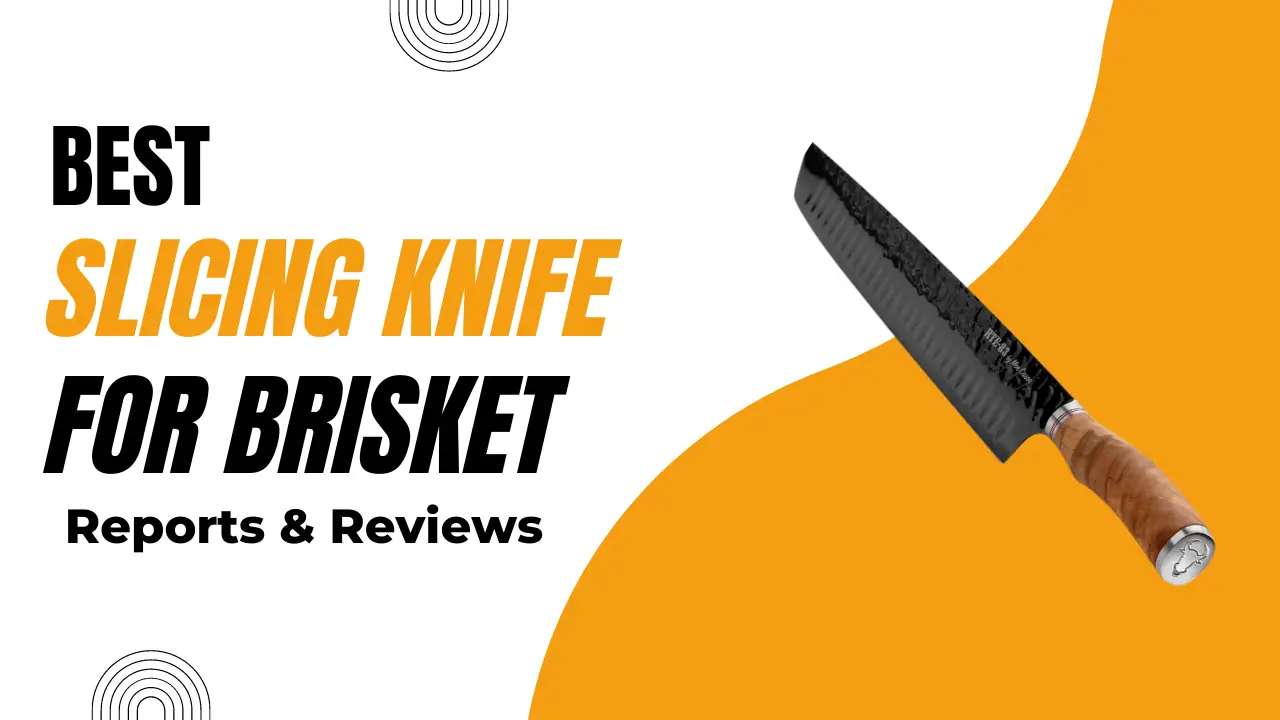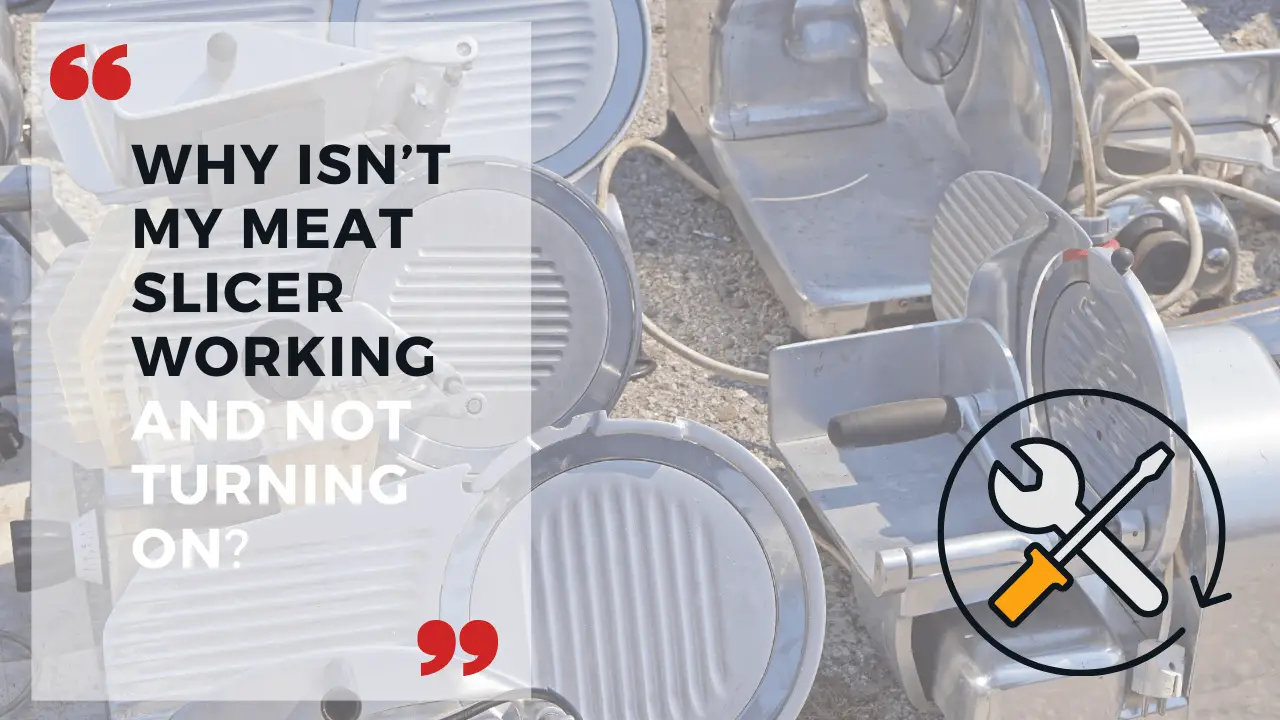Santoku knives are versatile Japanese-style knives known for their excellent performance in various kitchen tasks. While they are primarily designed for slicing, dicing, and chopping vegetables, they can also be used for cutting meat.
What Is A Santoku Knife?
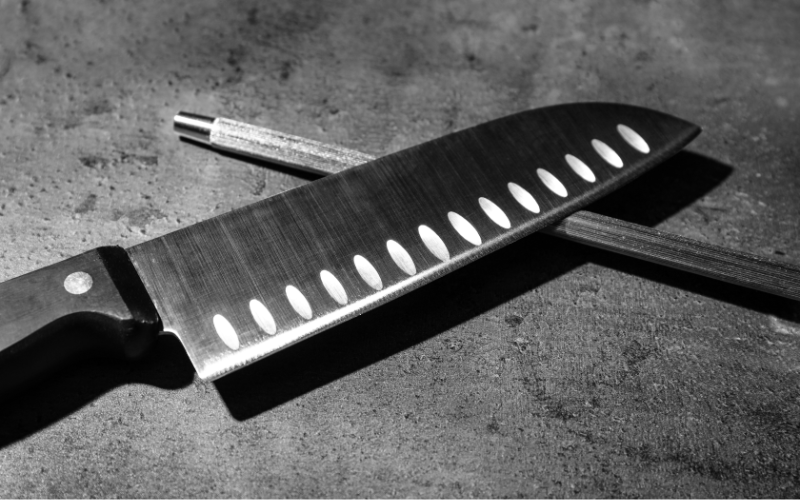
The Santoku knife is a Japanese-style knife typically 7 to 8 inches long with a straight edge and slightly rounded tip. It has a thinner blade than most Western-style knives, and the word “Santoku” actually means “three virtues” in Japanese, referring to its ability to perform three different types of cutting tasks slicing, dicing, and mincing.
Are Santoku Knives Good For Cutting Meat?
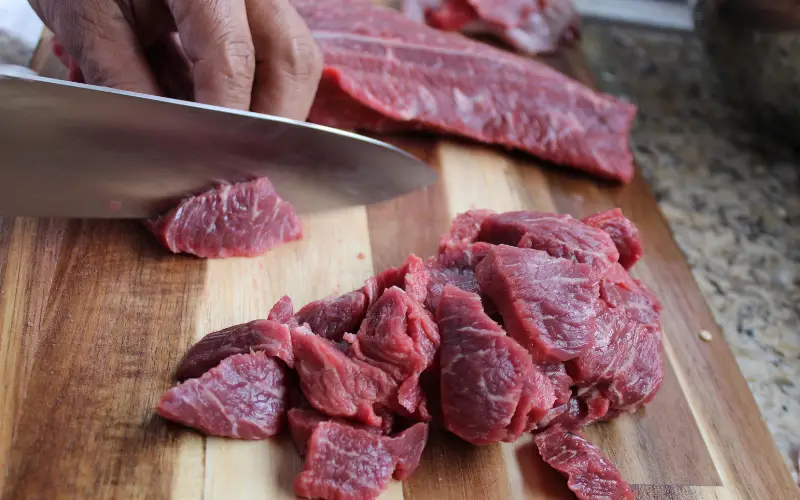
Santoku knives are great for slicing through meats like steak, chicken, or pork. The thinner blade makes it easier to make precise cuts, and the slightly curved blade makes it easier to maneuver around bones. The sharp edge also helps ensure you don’t apply too much pressure when cutting.
However, Santoku knives are unsuitable for larger or tougher meats like brisket or ribs. They aren’t strong enough to handle those tougher cuts. In that case, you’ll want to use a larger chef’s knife or a cleaver.
Why Choose A Santoku Knife For Cutting Meat?
Santoku knives are highly versatile kitchen tools for slicing, dicing, and chopping. The Japanese word ‘Santoku’ translates to “three virtues” or “three uses,” which perfectly encapsulates the knife’s multipurpose capabilities.
Advantages Of Using A Santoku Knife For Meat Cutting
- Sharpness: Santoku knives have a thinner and sharper blades than traditional Western knives, ensuring precise and clean cuts.
- Well-balanced Design: These knives offer excellent balance, providing optimal control and stability when cutting meat.
- Granton Edge: Many Santoku knives feature a Granton edge with hollow grooves on the blade, reducing friction and preventing food from sticking to the knife.
Selecting The Perfect Santoku Knife
To choose the ideal Santoku knife for your meat-cutting needs, consider the following factors:
- Blade Material: Opt for high-quality stainless steel or high-carbon stainless steel for exceptional sharpness and durability.
- Blade Length: A blade length of 5-7 inches is suitable for most users, providing adequate control and versatility.
- Handle: Look for an ergonomic handle made from wood or synthetic materials, ensuring a comfortable grip and secure handling.
How To Cut Whole Chicken Using Santoku Knives?
Step 1: Place the chicken on a cutting board, neck side up and legs downwards.
Step 2: Hold the santoku knife in your dominant hand at an angle to the bird’s breastbone. Slowly cut from one end of the breastbone to the other end. Cut through just one side of the bone – not both sides.
Step 3: Using the tip of your santoku knife, make small cuts around the chicken’s legs, starting at the thigh and working around in a circle to the joint. Cut through the joint to remove both legs from the body.
Step 4: Cut down one side of the ribcage until you reach the joint with the wings. Cut through this joint to remove one wing from the body, then repeat on the other side.
Step 5: Place your santoku knife at an angle against the breastbone and cut one side, separating the breasts from either side of the bone.
Step 6: Separate each chicken breast by cutting down along both sides of the breastbone.
Using a santoku knife to cut whole chicken is an efficient and easy way to prepare your poultry for cooking. Its sharp blade makes it simple to cut through meat, bone, and fat with minimal effort, ensuring that no part of the bird goes to waste.
Techniques For Cutting Meat With A Santoku Knife
Follow these expert tips for achieving precise, clean cuts when using a Santoku knife to slice meat:
- Trimming Fat: Use your Santoku knife’s sharp edge and thin blade to carefully trim excess fat and connective tissue.
- Slicing: To achieve even, thin slices, hold the knife at a slight angle and use a smooth, gliding motion, allowing the blade to do the work.
- Dicing: Cut it into strips for dicing meat, then dice by making perpendicular cuts. Use a steady, controlled motion, maintaining a firm grip on the handle.
- Chopping: For chopping meat, use a swift downward motion, taking advantage of the Santoku knife’s sharp edge and excellent balance for efficient cutting.
- Cubing: To cube meat, slice it into even strips, then cut each strip into smaller, equal-sized pieces. Make perpendicular cuts to form uniform cubes.
Cleaning And Maintaining Your Santoku Knife
Proper cleaning and maintenance are essential to ensure your Santoku knife’s longevity and performance. Follow these guidelines to keep your knife in top shape:
- Hand-washing: Always hand-wash your Santoku knife with warm, soapy water and a soft sponge. Avoid using abrasive materials that can damage the blade or handle.
- Drying: After washing, dry the knife immediately with a soft, clean towel to prevent water spots and reduce the risk of corrosion.
- Storage: Store your Santoku knife in a knife block, on a magnetic strip, or in a protective sheath to protect the blade from damage and maintain its sharpness.
- Sharpening: Regularly sharpen your Santoku knife using a whetstone, ceramic rod, or a designated knife sharpener to maintain its cutting edge.
What Is Santoku Knife Best For?
- Cutting meat: While not strictly designed for it, Santoku knives can be used to cut meat. They typically have a flat edge and a sharp tip, making picking out bones and fat easier. However, some prefer slicing knives when cutting large pieces of meat because they are better at creating smooth cuts.
- Slicing cheese: When it comes to slicing cheese, a Santoku knife is ideal. Its shorter blade makes it easy to control and the hollows on its edges help stop the cheese from sticking. It’s perfect for achieving thin, even slices of hard cheeses like Parmesan or Cheddar. Soft cheeses, like Brie or Camembert, are also great for slicing with a Santoku knife.
- Mincing meat or herbs: Santoku knives are specially designed to make quick work of mincing and slicing. Due to its curved edge, the blade shape allows the user to mince or slice ingredients into small, uniform pieces quickly. This is great for making finely minced herbs and vegetables and thinly sliced meats like beef or pork.
- Creating fine slices: Santoku knives are designed to create delicate slices and thin cuts of meat. Their broad, sharp blades allow you to make thin, precise cuts easily. Additionally, their curved edges prevent the blade from sticking to the food being cut. Because of this, it makes slicing various different types of meat easier than ever.
FAQs
What cutting board should I use with my Santoku knife?
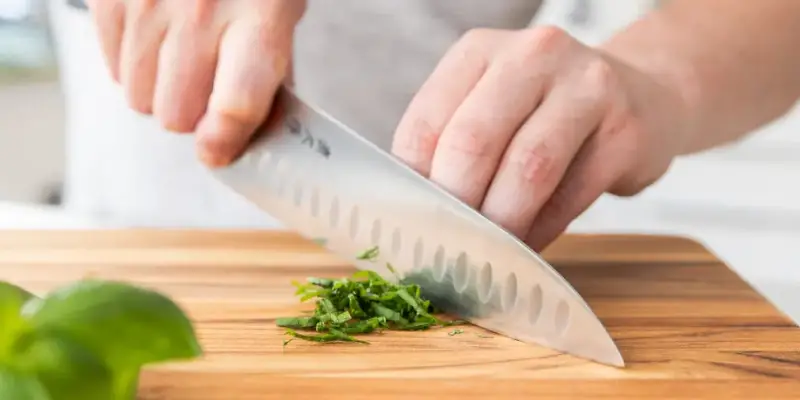
Choose a cutting board made from gentle materials on your knife’s blade, such as wood, bamboo, or high-quality plastic. Avoid using glass, marble, or granite cutting boards, as they can damage the blade’s edge and lead to dullness.
What is the difference between a Santoku knife and a Nakiri knife?
Both Santoku and Nakiri knives are popular Japanese kitchen knives, but they have distinct differences in design and function. A Santoku knife features a double-beveled blade with a slight curve and a sheepsfoot tip, making it versatile for slicing, dicing, and chopping. A Nakiri knife, on the other hand, has a straight, double-beveled blade with a squared-off tip designed specifically for precise vegetable cutting.
How Can I Improve My Knife Skills When Using A Santoku Knife?
To improve your knife skills with a Santoku knife, practice the following techniques:
- Hold the knife handle with your dominant hand, ensuring a firm and comfortable grip. Place your other hand on the spine of the blade for added control.
- Use your non-dominant hand to guide and stabilize the food you are cutting, employing a claw grip to keep your fingers safe from the blade.
- Use controlled, fluid motions when cutting, allowing the sharp blade to do the work. Avoid using excessive force or sawing motions.
- Regularly practice various cutting techniques to improve your skill and precision.
Can I Use A Santoku Knife For Filleting Fish?
While a Santoku knife can be used for general fish preparation tasks such as slicing and dicing, it may not be ideal for filleting fish. With its thin, flexible blade, a dedicated fillet knife is better suited for this purpose, as it allows for precise, close cuts along the fish’s bones and skin. However, a Santoku knife can be used cautiously and properly if a fillet knife is unavailable.
Conclusion
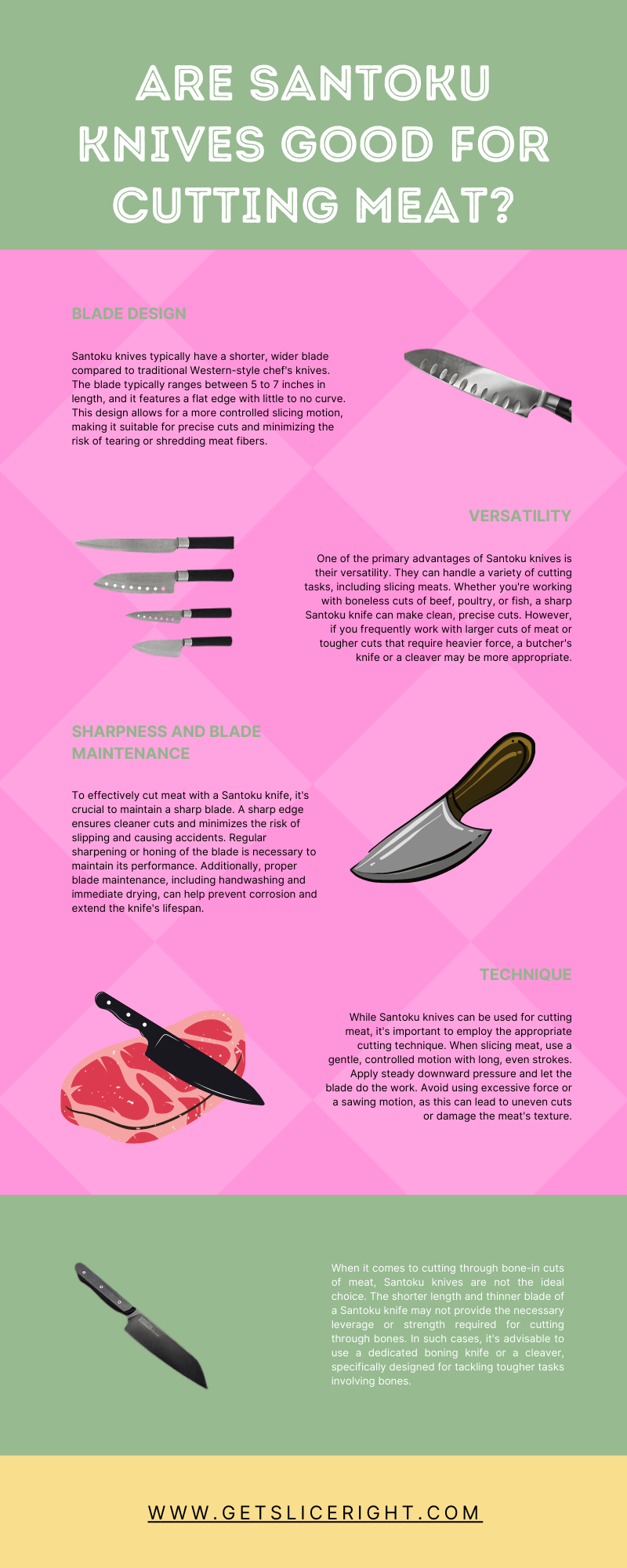
Santoku knives are an excellent choice for cutting meat, offering precise, clean cuts with their sharp, thin blades and well-balanced design. You can enjoy efficient and effortless meat preparation in your kitchen by selecting a high-quality Santoku knife, practicing proper cutting techniques, and carefully maintaining your knife.

Mario Batali is a renowned author, food enthusiast, and passionate chef who has dedicated his life to exploring the world of culinary arts. With a love for sharing his knowledge and experiences, Mario has become a prominent figure in the food blogging community, inspiring countless readers with his creativity and expertise.
In addition to his culinary prowess, Mario Batali is also a talented writer with a flair for engaging storytelling. He launched his own food blog to share his recipes, cooking tips, and personal experiences in the kitchen. Over time, Mario’s blog gained a loyal following of food enthusiasts who appreciate his unique approach to cooking and his dedication to using only the finest ingredients.
Mario Batali’s passion for food and his commitment to sharing his knowledge with others have made him a true inspiration in the world of culinary arts. Through his blog, cookbooks, and public appearances, Mario continues to spread his love of food and the joy of cooking with his ever-growing fanbase.


